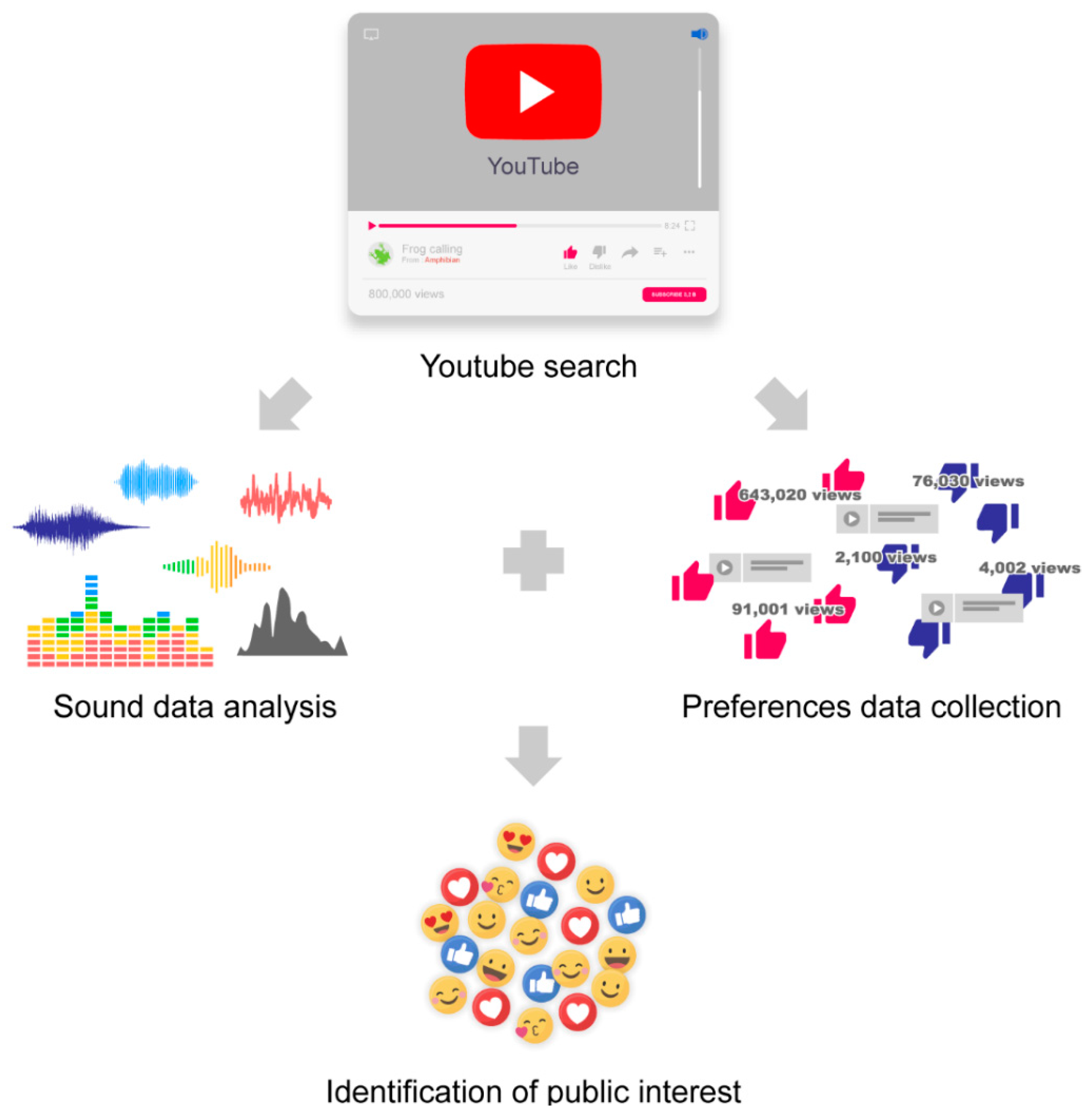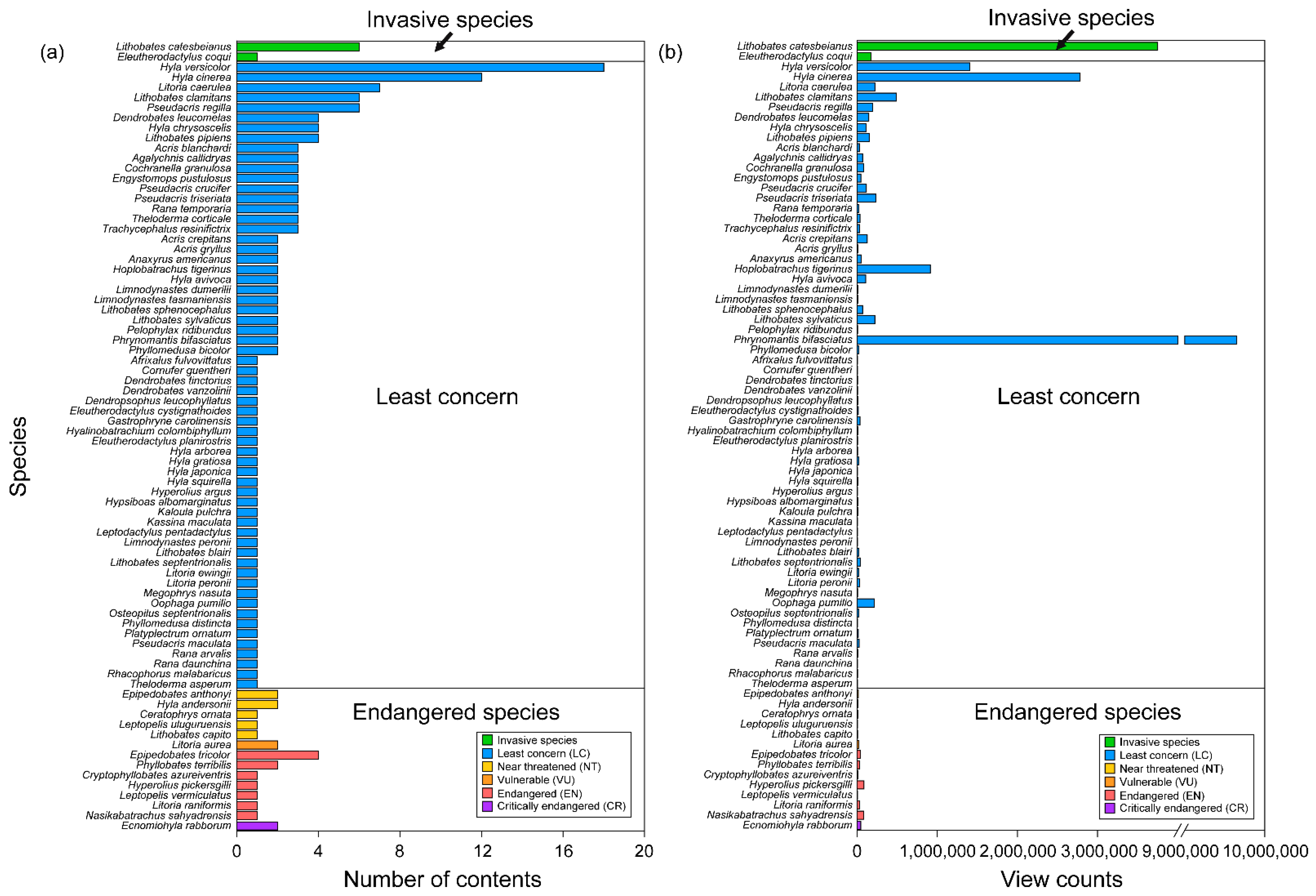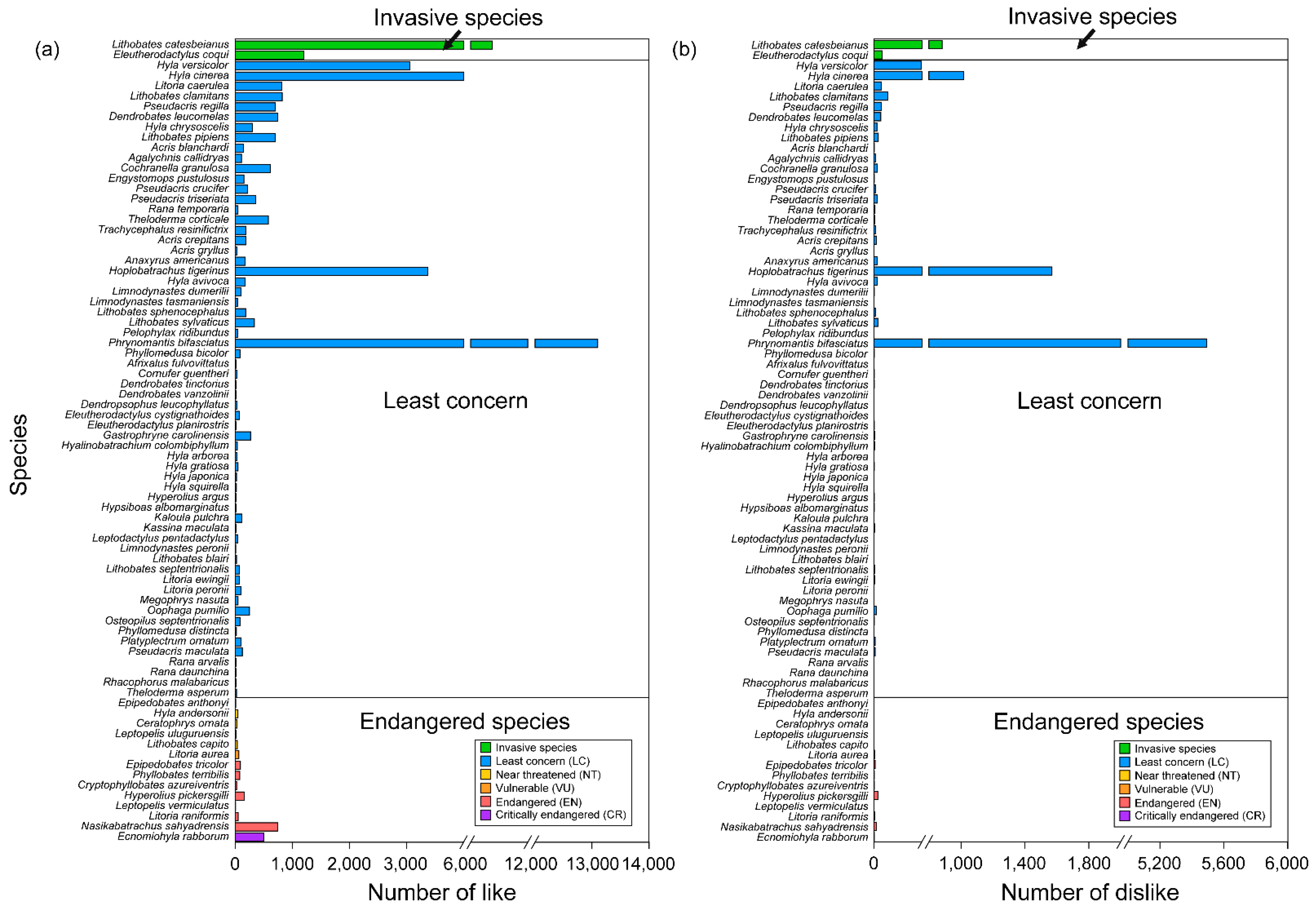Identifying Popular Frogs and Attractive Frog Calls from YouTube Data
Abstract
:1. Introduction
2. Materials and Methods
2.1. Data Collection
2.2. Sound Analysis
3. Results
3.1. Anuran Families and Species in Video Data
3.2. Number of Videos and Views According to Species
3.3. Likes and Dislikes According to Species
3.4. Advertisement-Calling Characteristics
4. Discussion
5. Conclusions
Author Contributions
Funding
Institutional Review Board Statement
Informed Consent Statement
Data Availability Statement
Conflicts of Interest
References
- Ladle, R.J.; Correia, R.A.; Do, Y.; Joo, G.J.; Malhado, A.C.; Proulx, R.; Roberge, J.M.; Jepson, P. Conservation culturomics. Front. Ecol. Environ. 2016, 14, 269–275. [Google Scholar] [CrossRef]
- Jarić, I.; Correia, R.A.; Brook, B.W.; Buettel, J.C.; Courchamp, F.; Di Minin, E.; Firth, J.A.; Gaston, K.J.; Jepson, P.; Kalinkat, G. iEcology: Harnessing large online resources to generate ecological insights. Trends Ecol. Evol. 2020, 35, 630–639. [Google Scholar] [CrossRef]
- Do, Y. Valuating aesthetic benefits of cultural ecosystem services using conservation culturomics. Ecosyst. Serv. 2019, 36, 100894. [Google Scholar] [CrossRef]
- Troumbis, A.Y.; Iosifidis, S. A decade of Google Trends-based Conservation culturomics research: A critical evaluation of an evolving epistemology. Biol. Conserv. 2020, 248, 108647. [Google Scholar] [CrossRef]
- Jarić, I.; Roll, U.; Arlinghaus, R.; Belmaker, J.; Chen, Y.; China, V.; Douda, K.; Essl, F.; Jähnig, S.C.; Jeschke, J.M. Expanding conservation culturomics and iEcology from terrestrial to aquatic realms. PLoS Biol. 2020, 18, e3000935. [Google Scholar] [CrossRef]
- Correia, R.A.; Ladle, R.; Jarić, I.; Malhado, A.C.; Mittermeier, J.C.; Roll, U.; Soriano-Redondo, A.; Veríssimo, D.; Fink, C.; Hausmann, A. Digital data sources and methods for conservation culturomics. Conserv. Biol. 2021, 35, 398–411. [Google Scholar] [CrossRef]
- LaDeau, S.; Han, B.; Rosi-Marshall, E.; Weathers, K. The next decade of big data in ecosystem science. Ecosystems 2017, 20, 274–283. [Google Scholar] [CrossRef]
- Jarić, I.; Bellard, C.; Correia, R.; Courchamp, F.; Douda, K.; Essl, F.; Jeschke, J.; Kalinkat, G.; Kalous, L.; Lennox, R. Invasion culturomics and iEcology. Conserv. Biol. 2021, 35, 447–451. [Google Scholar] [CrossRef] [PubMed]
- Wake, D.B.; Koo, M.S. Amphibians. Curr. Biol. 2018, 28, R1237–R1241. [Google Scholar] [CrossRef]
- AmphibiaWeb. Amphibians and People. Available online: https://amphibiaweb.org/declines/people.html (accessed on 13 April 2022).
- Lowe, S.; Browne, M.; Boudjelas, S.; De Poorter, M. 100 of the World’s Worst Invasive Alien Species: A Selection from the Global Invasive Species Database; Invasive Species Specialist Group (ISSG, Species Survival Commission of the International Union for the Conservation of Nature): Auckland, New Zealand, 2000. [Google Scholar]
- Collins, J.P.; Storfer, A. Global amphibian declines: Sorting the hypotheses. Divers. Distrib. 2003, 9, 89–98. [Google Scholar] [CrossRef]
- Stuart, S.N.; Chanson, J.S.; Cox, N.A.; Young, B.E.; Rodrigues, A.S.; Fischman, D.L.; Waller, R.W. Status and trends of amphibian declines and extinctions worldwide. Science 2004, 306, 1783–1786. [Google Scholar] [CrossRef] [PubMed]
- AmphibiaWeb. Browse by Family. Available online: https://amphibiaweb.org/lists/index.shtml (accessed on 13 April 2022).
- Wells, K.D. Anuran Vocal Communication. In The Ecology and Behavior of Amphibians; Wells, K.D., Ed.; University of Chicago Press: Chicago, IL, USA, 2007; pp. 268–337. [Google Scholar]
- Dylewski, Ł.; Mikula, P.; Tryjanowski, P.; Morelli, F.; Yosef, R. Social media and scientific research are complementary—YouTube and shrikes as a case study. Sci. Nat. 2017, 104, 48. [Google Scholar] [CrossRef] [PubMed]
- Jagiello, Z.A.; Dyderski, M.K.; Dylewski, Ł. What can we learn about the behaviour of red and grey squirrels from YouTube? Ecol. Inform. 2019, 51, 52–60. [Google Scholar] [CrossRef]
- Hampton, S.E.; Strasser, C.A.; Tewksbury, J.J.; Gram, W.K.; Budden, A.E.; Batcheller, A.L.; Duke, C.S.; Porter, J.H. Big data and the future of ecology. Front. Ecol. Environ. 2013, 11, 156–162. [Google Scholar] [CrossRef]
- Michener, W.K.; Jones, M.B. Ecoinformatics: Supporting ecology as a data-intensive science. Trends Ecol. Evol. 2012, 27, 85–93. [Google Scholar] [CrossRef]
- AmphibiaWeb. AmphibiaWeb. Available online: https://amphibiaweb.org (accessed on 13 April 2022).
- JASP Team. JASP (Version 0.14.1) [Computer Software]. 2020. Available online: https://jasp-stats.org/ (accessed on 14 May 2022).
- AmphibiaWeb. Hylidae. Available online: https://amphibiaweb.org/lists/Hylidae.shtml (accessed on 13 April 2022).
- Conant, R.; Collins, J.T. A Field Guide to Reptiles & Amphibians: Eastern and Central North America; Houghton Mifflin Harcourt: Boston, MA, USA, 1998; Volume 12. [Google Scholar]
- Altherr, S.; Goyenechea, A.; Schubert, D.J. The International Trade in Frogs’ Legs and Its Ecological Impact; Pro Wildlife Munich (DE): München, Germany, 2011. [Google Scholar]
- Lever, C. Naturalized Amphibians and Reptiles of the World; Oxford University Press: New York, NY, USA, 2003. [Google Scholar]
- AmphibiaWeb. Rana Catesbeiana: Bullfrog. Available online: https://amphibiaweb.org/species/4999 (accessed on 13 April 2022).
- Albert, C.; Luque, G.M.; Courchamp, F. The twenty most charismatic species. PLoS ONE 2018, 13, e0199149. [Google Scholar] [CrossRef]
- Lorimer, J. Nonhuman charisma. Environ. Plan. D: Soc. Space 2007, 25, 911–932. [Google Scholar] [CrossRef]
- Crowley, S.L.; Hinchliffe, S.; McDonald, R.A. The parakeet protectors: Understanding opposition to introduced species management. J. Environ. Manag. 2019, 229, 120–132. [Google Scholar] [CrossRef]
- Jarić, I.; Courchamp, F.; Correia, R.A.; Crowley, S.L.; Essl, F.; Fischer, A.; González-Moreno, P.; Kalinkat, G.; Lambin, X.; Lenzner, B. The role of species charisma in biological invasions. Front. Ecol. Environ. 2020, 18, 345–353. [Google Scholar] [CrossRef]
- Beever, E.A.; Simberloff, D.; Crowley, S.L.; Al-Chokhachy, R.; Jackson, H.A.; Petersen, S.L. Social–ecological mismatches create conservation challenges in introduced species management. Front. Ecol. Environ. 2019, 17, 117–125. [Google Scholar] [CrossRef]
- Colléony, A.; Clayton, S.; Couvet, D.; Saint Jalme, M.; Prévot, A.-C. Human preferences for species conservation: Animal charisma trumps endangered status. Biol. Conserv. 2017, 206, 263–269. [Google Scholar] [CrossRef]
- Amuakwa-Mensah, F.; Bärenbold, R.; Riemer, O. Deriving a benefit transfer function for threatened and endangered species in interaction with their level of charisma. Environments 2018, 5, 31. [Google Scholar] [CrossRef]
- Reeve, R. Policing International Trade in Endangered Species: The CITES Treaty and Compliance; The Royal Institute of International Affairs and Earthscan Publications: London, UK, 2014. [Google Scholar]
- Chucholl, C.; Wendler, F. Positive selection of beautiful invaders: Long-term persistence and bio-invasion risk of freshwater crayfish in the pet trade. Biol. Invasions 2017, 19, 197–208. [Google Scholar] [CrossRef]
- EDMONDS, D. Poison Frogs Traded and Maintained by US Private Breeders. Herpetol. Rev. 2021, 52, 779–786. [Google Scholar]
- Yang, W.; Kang, J. Soundscape and sound preferences in urban squares: A case study in Sheffield. J. Urban Des. 2005, 10, 61–80. [Google Scholar] [CrossRef]
- Yu, L.; Kang, J. Factors influencing the sound preference in urban open spaces. Appl. Acoust. 2010, 71, 622–633. [Google Scholar] [CrossRef]
- Pijanowski, B.C.; Villanueva-Rivera, L.J.; Dumyahn, S.L.; Farina, A.; Krause, B.L.; Napoletano, B.M.; Gage, S.H.; Pieretti, N. Soundscape ecology: The science of sound in the landscape. BioScience 2011, 61, 203–216. [Google Scholar] [CrossRef]
- Zhang, Y.; Kang, J.; Kang, J. Effects of soundscape on the environmental restoration in urban natural environments. Noise Health 2017, 19, 65. [Google Scholar]
- Luo, H.; Deng, L.; Jiang, S.; Song, C.; Fu, E.; Ma, J.; Sun, L.; Huang, Z.; Jiang, M.; Zhu, C. Assessing the influence of individual factors on visual and auditory preference for rural landscape: The case of Chengdu, China. J. Environ. Plan. Manag. 2022, 65, 727–744. [Google Scholar] [CrossRef]
- Soeta, Y.; Kagawa, H. Subjective preferences for birdsong and insect song in equal sound pressure level. Appl. Sci. 2020, 10, 849. [Google Scholar] [CrossRef]
- Hedblom, M.; Heyman, E.; Antonsson, H.; Gunnarsson, B. Bird song diversity influences young people’s appreciation of urban landscapes. Urban For. Urban Green. 2014, 13, 469–474. [Google Scholar] [CrossRef]




| Contents | Group | n | Mean ± SD | Median | IQR | From 5% to 95% |
|---|---|---|---|---|---|---|
| Number of videos per species | Overall | 78 | 2.231 ± 2.527 | 1 | 1–2.25 | 1–6.05 |
| Invasive | 2 | 3.5 ± 3.536 | 3.5 | 1–6 | 1–6 | |
| Least concern | 62 | 2.339 ± 2.746 | 1 | 1–3 | 1–6.85 | |
| Endangered | 14 | 1.571 ± 0.8516 | 1 | 1–2 | 1–4 | |
| View counts per species | Overall | 78 | 283,637 ± 1,206,233 | 17,488 | 4818–81,288 | 2427–1,476,480 |
| Invasive | 2 | 1,963,216 ± 2,529,887 | 1,963,216 | 1,74,315–3,752,116 | 174,315–3,752,116 | |
| Least concern | 62 | 287,705 ± 1,274,275 | 17,488 | 4648–106,427 | 2423–1,333,585 | |
| Endangered | 14 | 25,680 ± 27,113 | 14,534 | 5164–39,252 | 3771–82,875 |
| Contents | Group | n | Mean ± SD | Median | IQR | From 5% to 95% |
|---|---|---|---|---|---|---|
| Number of likes per species | Overall | 78 | 546.2 ± 1739 | 75.5 | 22.75–254.3 | 10.9–3410 |
| Invasive | 2 | 3788 ± 3660 | 3788 | 1200–6376 | 1200–6376 | |
| Least concern | 62 | 535.1 ± 1789 | 82.5 | 22–254.3 | 12.3–3329 | |
| Endangered | 14 | 132.4 ± 216.5 | 49.5 | 20.5–107.3 | 6–741 | |
| Number of dislikes per species | Overall | 78 | 127.1 ± 74.47 | 3 | 1–16 | 0–888.7 |
| Invasive | 2 | 467.5 ± 414.5 | 467.5 | 53–882 | 53–882 | |
| Least concern | 62 | 143.8 ± 92.71 | 3 | 1–16.75 | 0–908.1 | |
| Endangered | 14 | 4.786 ± 1.948 | 2 | 0–6.5 | 0–25 |
| Predicted Variable | Predictor Variable | Coeff. | Std. Err. | Beta | t | p | R2 | F (p) | Df 1, 2 |
|---|---|---|---|---|---|---|---|---|---|
| Frequency (Hz) | (Intercept) | 2052.275 | 88.03 | 23.313 | <0.001 | 0.046 | 2.707 (0.047) | 3, 170 | |
| Views | 0.001 | 5.918 × 10−4 | 0.71 | 1.857 | 0.065 | ||||
| Likes | −0.954 | 0.406 | −0.866 | −2.351 | 0.020 | ||||
| Dislikes | 0.07 | 0.729 | 0.024 | 0.096 | 0.924 |
Publisher’s Note: MDPI stays neutral with regard to jurisdictional claims in published maps and institutional affiliations. |
© 2022 by the authors. Licensee MDPI, Basel, Switzerland. This article is an open access article distributed under the terms and conditions of the Creative Commons Attribution (CC BY) license (https://creativecommons.org/licenses/by/4.0/).
Share and Cite
Park, J.-K.; Park, W.-B.; Do, Y. Identifying Popular Frogs and Attractive Frog Calls from YouTube Data. Sustainability 2022, 14, 10258. https://doi.org/10.3390/su141610258
Park J-K, Park W-B, Do Y. Identifying Popular Frogs and Attractive Frog Calls from YouTube Data. Sustainability. 2022; 14(16):10258. https://doi.org/10.3390/su141610258
Chicago/Turabian StylePark, Jun-Kyu, Woong-Bae Park, and Yuno Do. 2022. "Identifying Popular Frogs and Attractive Frog Calls from YouTube Data" Sustainability 14, no. 16: 10258. https://doi.org/10.3390/su141610258
APA StylePark, J.-K., Park, W.-B., & Do, Y. (2022). Identifying Popular Frogs and Attractive Frog Calls from YouTube Data. Sustainability, 14(16), 10258. https://doi.org/10.3390/su141610258






